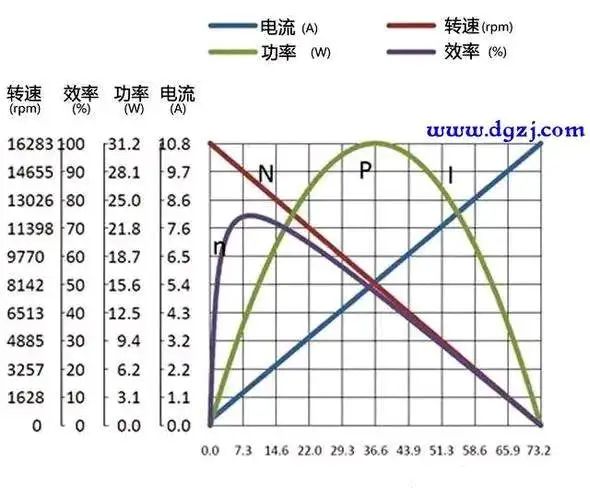I. Current Variation
According to Ohm’s Law, the relationship among current I, voltage U, and resistance R is I = U/R. In motors, resistance R (mainly stator resistance and rotor resistance) usually does not change much, so a decrease in voltage U will directly lead to an increase in current I. For different types of motors, the specific manifestations of current variation may vary.
Specific manifestations:
DC motor: For brushless DC motors (BLDC) and brushed DC motors, when the voltage drops and the load remains constant, the current will significantly increase. This is because the motor requires more current to maintain the original torque output.
AC motor: For asynchronous motors, although the motor will automatically reduce its speed to match the load when the voltage drops, in cases where the load is heavy or changes rapidly, the current may still increase. For synchronous motors, when the voltage drops and the load remains unchanged, theoretically the current change is not significant. However, if the load increases, the current will also increase.
II. Torque and Speed Changes
Torque Changes: A decrease in voltage typically leads to a reduction in the motor’s torque. Since torque is directly proportional to the product of current and magnetic flux, when the voltage drops, although the current increases, the magnetic flux may decrease due to insufficient voltage, resulting in a overall decrease in torque. However, in certain cases, such as in DC motors, if the current increases sufficiently, it may compensate for the reduction in magnetic flux to some extent, maintaining the torque relatively stable.
Speed Changes: For AC motors, especially asynchronous and synchronous motors, a decrease in voltage directly leads to a reduction in speed. This is because the speed of the motor is related to the frequency of the power supply and the number of poles of the motor, and a decrease in voltage affects the electromagnetic field strength of the motor, thereby reducing the speed. For DC motors, the speed is directly proportional to the voltage, so a decrease in voltage causes the speed to decrease accordingly.
III. Efficiency and Heat Generation
Efficiency Decrease: A decrease in voltage will lead to a reduction in motor efficiency. When the motor operates at a lower voltage, it requires more current to maintain the output power. The increase in current will lead to an increase in copper loss and iron loss of the motor, thereby reducing the overall efficiency.
Heat Increase: Due to the increase in current and the decrease in efficiency, the motor will generate more heat during operation. This not only accelerates the aging and wear of the motor but may also trigger the activation of the overheat protection device, causing the motor to stop.
IV. Impact on Motor Lifespan
Operating the motor in an environment with unstable voltage or low voltage for a long time will significantly shorten its lifespan. This is because the reduction in voltage leads to increased current, fluctuating torque, decreased speed, and reduced efficiency, all of which can cause damage to the internal structure and electrical performance of the motor. Moreover, the increase in heat generation will accelerate the aging process of the motor’s insulation materials.
V. Countermeasures
To mitigate the impact of voltage reduction on the motor, the following measures can be taken:
Optimize the power supply system: Ensure the stability of the power grid voltage and avoid voltage fluctuations that may cause impacts on the motor.
Select appropriate motors: When designing and selecting, fully consider the factors of voltage fluctuations and choose motors with a wider voltage adaptability range.
Install voltage stabilizers: Add voltage stabilizers or regulators at the input end of the motor to maintain voltage stability.
Enhance maintenance and upkeep: Regularly inspect and maintain the motor to promptly detect and address potential issues, thereby extending the service life of the motor.
In conclusion, the impact of voltage reduction on the motor is multi-faceted, including changes in current, torque and speed, efficiency and heat generation, as well as the influence on the motor’s lifespan. Therefore, in practical applications, effective measures need to be taken to alleviate these effects and ensure the safe and stable operation of the motor.
Post time: Jun-18-2025

